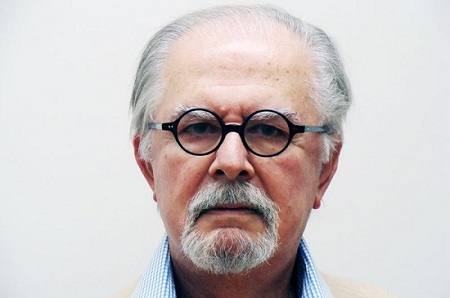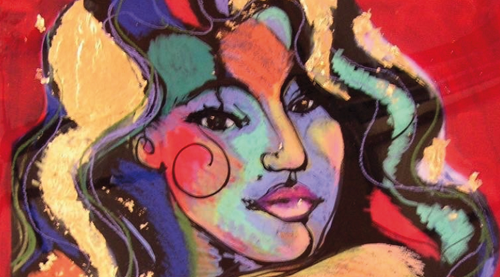FERNANDO BOTERO

“Art is important because when people start to forget, art reminds them what happened. Like [Picasso’s] Guernica. People would not remember the tragedy of Guernica today if it were not for that painting.”
Fernando Botero Angulo was born 1932 in Medellín, located in a central region of the Andes Mountains, and the second largest city in Colombia. His signature style—known as “Boterismo”—depicts figures exaggerated in shape and size, and often represents political criticism, national problems, or personal humor. He is widely considered one of the most recognized and celebrated living artists from Latin America.
His uncle, who took on an important role in the artist’s life after the death of Botero’s father in 1936, enrolled him in a training school for bullfighters when he was 12 years old. But Botero was already a keen artist, much more interested in painting the bulls than in fighting them. “Before anything else,” he said later, “I started painting bulls and matadors. That was my initiation to paint.”
His early work, some of which was published in the city newspaper El Colombiano in 1948, was inspired by pre-Colombian and Spanish colonial art and the political murals of Mexican artist Diego Rivera, as well as the works of Botero’s artistic idols, Francisco de Goya and Diego Velázquez.
Success came quickly. He moved to Bogotá in 1951 and within a few months opened his first one-man show, at the Galería Leo Matiz . The following year, he traveled to Madrid to study at the Academia de San Fernando , making a living selling copies of paintings hanging in the Prado to tourists.
Botero’s “eureka” moment came in 1956 while he was living in Mexico City. He painted a mandolin with an unusually tiny sound hole, leading the instrument to take on exaggerated proportions. Botero was excited by these seemingly new possibilities, and the experience ignited a lifelong exploration of the “sensuality of form.” By the time he moved to New York City in 1960, his trademark style of bloated human and animal figures—depicted using flat, bright color and prominently outlined forms—was in place.
“An artist is attracted to certain kinds of form without knowing why. You adopt a position intuitively; only later do you attempt to rationalize or even justify it.”
After gaining international acclaim with his work, Botero moved to Paris in 1973 and shifted his focus to sculpture. His new work built on the style of his painting and continued to bloat and expand his subjects. “I had wanted to be a sculptor throughout life,” he said. “But to do so I had to stop painting.”
During his career, Botero has donated more than 300 works to the Museum of Antioquia in Medellín and to the Banco de la República in Bogotá, now known as the Botero Museum, one of Latin America’s most important international art collections.
Through his career, Botero has sometimes used his work to satirize the politics or troubles of his country, but he has generally preferred to create a sense of tranquility and joy through his work. “Art should be an oasis,” he said. “A place of refuge from the hardness of life.”
Currently, the artist has a number of houses and studios in several countries, each dedicated to a specific artistic medium. In Paris, Botero paints his large oil paintings, in Monte Carlo and New York he uses pastel oils and watercolors, in Zihuatanejo and Colombia he draws, and at his home in Tuscany he creates his bronze sculptures.
“I love art so much because of curiosity. At the start of a painting, I know 10 percent of what the painting will be, and then I have to improvise the whole thing.”
“Art is important because when people start to forget, art reminds them what happened. Like [Picasso’s] Guernica. People would not remember the tragedy of Guernica today if it were not for that painting.”
Fernando Botero Angulo was born 1932 in Medellín, located in a central region of the Andes Mountains, and the second largest city in Colombia. His signature style—known as “Boterismo”—depicts figures exaggerated in shape and size, and often represents political criticism, national problems, or personal humor. He is widely considered one of the most recognized and celebrated living artists from Latin America.
His uncle, who took on an important role in the artist’s life after the death of Botero’s father in 1936, enrolled him in a training school for bullfighters when he was 12 years old. But Botero was already a keen artist, much more interested in painting the bulls than in fighting them. “Before anything else,” he said later, “I started painting bulls and matadors. That was my initiation to paint.”
His early work, some of which was published in the city newspaper El Colombiano in 1948, was inspired by pre-Colombian and Spanish colonial art and the political murals of Mexican artist Diego Rivera, as well as the works of Botero’s artistic idols, Francisco de Goya and Diego Velázquez.
Success came quickly. He moved to Bogotá in 1951 and within a few months opened his first one-man show, at the Galería Leo Matiz . The following year, he traveled to Madrid to study at the Academia de San Fernando , making a living selling copies of paintings hanging in the Prado to tourists.
Botero’s “eureka” moment came in 1956 while he was living in Mexico City. He painted a mandolin with an unusually tiny sound hole, leading the instrument to take on exaggerated proportions. Botero was excited by these seemingly new possibilities, and the experience ignited a lifelong exploration of the “sensuality of form.” By the time he moved to New York City in 1960, his trademark style of bloated human and animal figures—depicted using flat, bright color and prominently outlined forms—was in place.
“An artist is attracted to certain kinds of form without knowing why. You adopt a position intuitively; only later do you attempt to rationalize or even justify it.”
After gaining international acclaim with his work, Botero moved to Paris in 1973 and shifted his focus to sculpture. His new work built on the style of his painting and continued to bloat and expand his subjects. “I had wanted to be a sculptor throughout life,” he said. “But to do so I had to stop painting.”
During his career, Botero has donated more than 300 works to the Museum of Antioquia in Medellín and to the Banco de la República in Bogotá, now known as the Botero Museum, one of Latin America’s most important international art collections.
Through his career, Botero has sometimes used his work to satirize the politics or troubles of his country, but he has generally preferred to create a sense of tranquility and joy through his work. “Art should be an oasis,” he said. “A place of refuge from the hardness of life.”
Currently, the artist has a number of houses and studios in several countries, each dedicated to a specific artistic medium. In Paris, Botero paints his large oil paintings, in Monte Carlo and New York he uses pastel oils and watercolors, in Zihuatanejo and Colombia he draws, and at his home in Tuscany he creates his bronze sculptures.
“I love art so much because of curiosity. At the start of a painting, I know 10 percent of what the painting will be, and then I have to improvise the whole thing.”
Due to the evolving COVID-19 situation, the Cultural Center will take additional precautions to keep everyone on our campus safe. The improvements we made to our ventilation system and other aspects of our facility during the pandemic continue to contribute to the safety of our constituents.
However, until further notice—for the health, safety, and well-being of our patrons, staff, volunteers, and creatives—the Cultural Center of Cape Cod requires that guests attending indoor ticketed events or classes must be vaccinated or provide a negative COVID test taken within 72 hours.
At check-in, all guests must either:
• Present proof that they meet the CDC definition of being fully vaccinated against COVID-19, either in the form of a physical vaccination card or a photo of the card.
Or
• Present proof of a negative COVID test with that test taken within 72 hours of the indoor event/class.
For your convenience, you may choose to upload your vaccination card here , or send a photo of the vaccination card or negative COVID test with your full name in advance to vax@cultural-center.org . Please note all guests within a party will need to show proof of vaccination or negative COVID test.
Children under twelve must wear masks at all times when indoors.
HAPPENINGS

Thursday, October 21, from 6:30–8:30pm
Figure Painting & Drawing
With Sarah Holl
In this class, students can practice their drawing or painting skills while working from a live model. Students will be encouraged to find their own voices and explore various mediums. Students will receive individual instruction as well as group critiques.
Open to all levels of experience.
$25
BOOK TODAY!
